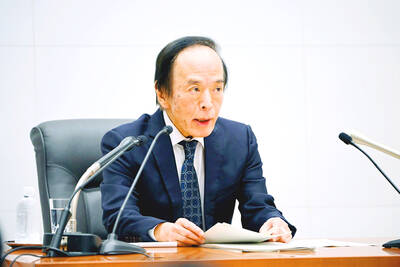Social media influencers have embraced artificial intelligence (AI) to spice up their content, but they are also facing growing competition from AI-generated Instagramers, TikTokers and YouTubers.
Sporting pink hair and posing in lingerie, swimsuits or gym outfits, Aitana Lopez has more than 300,000 followers on Instagram where she is described as a “gamer at heart” and “fitness lover” — except she is not real.
Aitana was created by The Clueless, a Barcelona-based company that describes itself as an “AI modeling agency” run by “visionaries on a mission to redefine the world of influencers.”

Photo: AFP
The Clueless project manager Sofia Novales said “rising costs associated with human influencers” were a reason for the firm’s creation.
“Virtual models, being digital, present a more economical alternative,” Novales said.
Another plus: total control over content.
“The advantages lie in unparalleled creative control, allowing seamless decisionmaking on image, fashion and aesthetics without the need for physical photoshoots,” Novales said.
The rise of AI has fueled concerns about the proliferation of deepfake videos that could be used maliciously.
Meta Platforms Inc, which owns Facebook and Instagram, on Friday said that it would start putting “Made with AI labels” on AI-generated content next month.
AI presents a huge business opportunity for content creators: The influencer market is expected to grow rapidly, from US$16.5 billion in 2022 to nearly US$200 billion by 2032, Allied Market Research has said.
Using virtual influencers is not new — Barbie already has millions of followers on Instagram — but they are now being used in advertisements where they cannot be told apart from a real person.
Take Lil Miquela, a “19-year-old Robot living in LA” created by a California agency in 2016.
With 2.6 million followers on Instagram and 3.5 million on TikTok, Lil Maqueta has promoted brands as big as BMW AG.
The idea was to “create something never seen before,” the German premium automaker said in a statement.
“Attracting a younger, technology-savvy generation is for us the icing on the cake,” it added.
Maud Lejeune, cofounder and CEO of Paris-based digital strategy agency AD Crew, said that it is not difficult for the public to accept AI influencers.
“It’s like actors on TV: We know it isn’t real yet we follow them and we find it interesting, it’s like watching a mini-series,” Lejeune said.
AD Crew represents more than 30 influencers, but Lejeune created her own virtual influencer, Metagaya, two years ago.
“The current level of design didn’t exist then. It’s technical, you’ve got to dress them, take photos for the background, create a story,” said Lejeune, acknowledging that Metagaya did not turn out very well.
The rapid technological progress brought by the likes of OpenAI’s Sora video generator could make it easier to create and operate realistic virtual influencers.
Human influencers are also seizing on AI technology to make better videos. In France, Charles Sterlings sees an opportunity to improve translations.
He uses tools on platforms such as HeyGen and Rask.ai to automatically translate and lip-sync his video posts into English and Spanish.
Sterlings also uses Deepshot, a platform that allows users to create deepfakes by changing the words and mouth movements of people in real videos.
He said it took him just a few minutes and a few dollars to manipulate a video of French President Emmanuel Macron.
Yet Sterlings sees the technology as a competitor as well as a useful tool.
“Anyone with a phone can be an influencer, but eventually, it will be artificial intelligence, available 24 hours a day, and much cheaper to develop,” he said.
For Lejeune, AI can help influencers produce more content.
“It’s tough to put yourself in front of the camera for a long time and certain creators burn out... Maybe AI will provide a new way to create without exposing oneself,” she said.

Taiwan Semiconductor Manufacturing Co (TSMC, 台積電) last week recorded an increase in the number of shareholders to the highest in almost eight months, despite its share price falling 3.38 percent from the previous week, Taiwan Stock Exchange data released on Saturday showed. As of Friday, TSMC had 1.88 million shareholders, the most since the week of April 25 and an increase of 31,870 from the previous week, the data showed. The number of shareholders jumped despite a drop of NT$50 (US$1.59), or 3.38 percent, in TSMC’s share price from a week earlier to NT$1,430, as investors took profits from their earlier gains

In a high-security Shenzhen laboratory, Chinese scientists have built what Washington has spent years trying to prevent: a prototype of a machine capable of producing the cutting-edge semiconductor chips that power artificial intelligence (AI), smartphones and weapons central to Western military dominance, Reuters has learned. Completed early this year and undergoing testing, the prototype fills nearly an entire factory floor. It was built by a team of former engineers from Dutch semiconductor giant ASML who reverse-engineered the company’s extreme ultraviolet lithography (EUV) machines, according to two people with knowledge of the project. EUV machines sit at the heart of a technological Cold

TAIWAN VALUE CHAIN: Foxtron is to fully own Luxgen following the transaction and it plans to launch a new electric model, the Foxtron Bria, in Taiwan next year Yulon Motor Co (裕隆汽車) yesterday said that its board of directors approved the disposal of its electric vehicle (EV) unit, Luxgen Motor Co (納智捷汽車), to Foxtron Vehicle Technologies Co (鴻華先進) for NT$787.6 million (US$24.98 million). Foxtron, a half-half joint venture between Yulon affiliate Hua-Chuang Automobile Information Technical Center Co (華創車電) and Hon Hai Precision Industry Co (鴻海精密), expects to wrap up the deal in the first quarter of next year. Foxtron would fully own Luxgen following the transaction, including five car distributing companies, outlets and all employees. The deal is subject to the approval of the Fair Trade Commission, Foxtron said. “Foxtron will be

INFLATION CONSIDERATION: The BOJ governor said that it would ‘keep making appropriate decisions’ and would adjust depending on the economy and prices The Bank of Japan (BOJ) yesterday raised its benchmark interest rate to the highest in 30 years and said more increases are in the pipeline if conditions allow, in a sign of growing conviction that it can attain the stable inflation target it has pursued for more than a decade. Bank of Japan Governor Kazuo Ueda’s policy board increased the rate by 0.2 percentage points to 0.75 percent, in a unanimous decision, the bank said in a statement. The central bank cited the rising likelihood of its economic outlook being realized. The rate change was expected by all 50 economists surveyed by Bloomberg. The